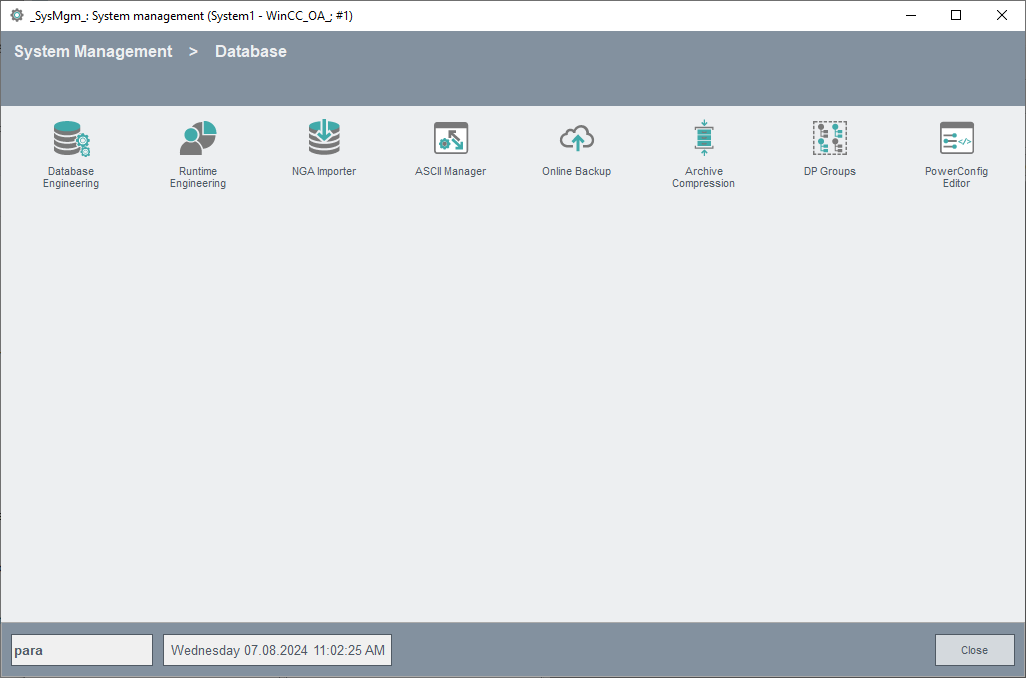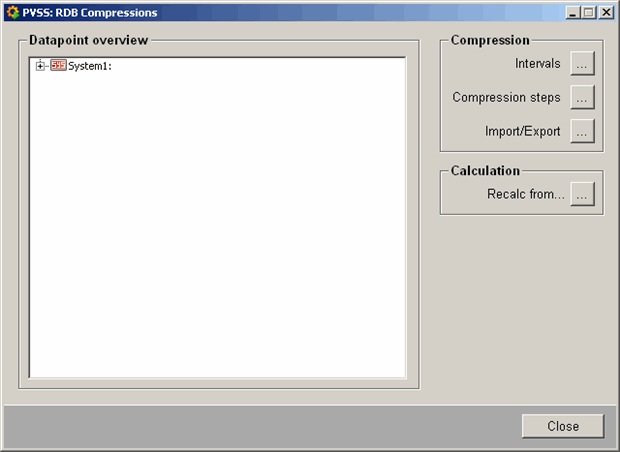RDB Compression Configuration
For the configuration of the RDB compression the following prior preparing steps had to be performed:
-
The connection to the database is established.
-
The data point elements, whose values should be compressed, are of the type float, uint or int.
-
The data point elements, whose values should be compressed, have an _archive config (or PowerConfig, respectively) to which an RDB archive group has been assigned (see Setting archive group parameters).
The configuration of the RDB compression takes place using WinCC OA configuration panels, which are opened via the system management. Open the Database tab of the system management and click RDB Compression to open the main configuration panel over which the further configuration panels can be opened.


Over the main configuration panel it is possible to open each other RDB compression panel, which is relevant when working with RDB compressions:
-
Intervals button - opens a panel for creation of new compression intervals and for overview and editing existing compression intervals. A compression interval defines the interval for the calculation of the values of a data point element.
-
Compression Steps button - opens a panel for creation of new compression steps and for overview and editing existing compression steps. A compression step defines the connection of an interval with an arithmetic function.
-
Import/Export button - opens the ASCII panel that provides the import and export of an RDB compression configuration (see ASCII Import and Export of a RDB Compression Configuration).
-
Synchronizing 2x2 button - for online values and alarms it is possible to perform a synchronization with the redundant stand-by database using a special database link. Thereby it is also possible to copy compression intervals, steps and calculations form the active database to the stand-by database by a click on this button. The calculation takes place in the database. For this function the Disaster Recovery System must be installed and embedded into the project and database configuration must take place (see Requirements and Installation).
-
Recalc from... button - allows you to enter a date from which the compressed values, starting with the smallest interval, should be recalculated. This feature is useful for example in case of a loss of database connection, whereby the compression calculations during the connection loss were possibly not calculated correctly. The following restrictions should be noted:
-
-
The relevant data must be online, i.e. outsourced values cannot be recalculated.
-
Can only be used in projects where queryRDBdirect = 1.
-
May affect the DB performance depending on how far the entered date lies in the past.
-
Values that are written "late" to the database (e.g. in case of a database failure) are detected and the calculation of the relevant intervals is restarted (does not apply for correction values). This applies only to values that arrive in chronological order to the database. Procedure: If it is recognized that "late" values were written to the database, the already calculated compression values are deleted. During the next iteration of the concerned compression calculation, the intervals that must be newly calculated are recalculated, for example: If the values for the "5min_sum" compression were deleted, then these will be recalculated with the next automatic calculation of the "5min_sum" compression (delay = 5 minutes + delay). The same applies to daily values, weekly values, etc.
-
In the tree view of the main configuration panel the following configuration steps are proceed:
-
-
Adding of a data point element to the RDB compression
-
Adding a compression calculation to a data point element
-
New compression calculation - description of the panel for creation of a new compression calculation
-
-
Mass configuration of multiple data point elements - provides the take-over of compression calculations, which have been configured for the data point elements of a master data point, to all data points of the corresponding data point type.
-
Close button - closes the RDB compression panel.



